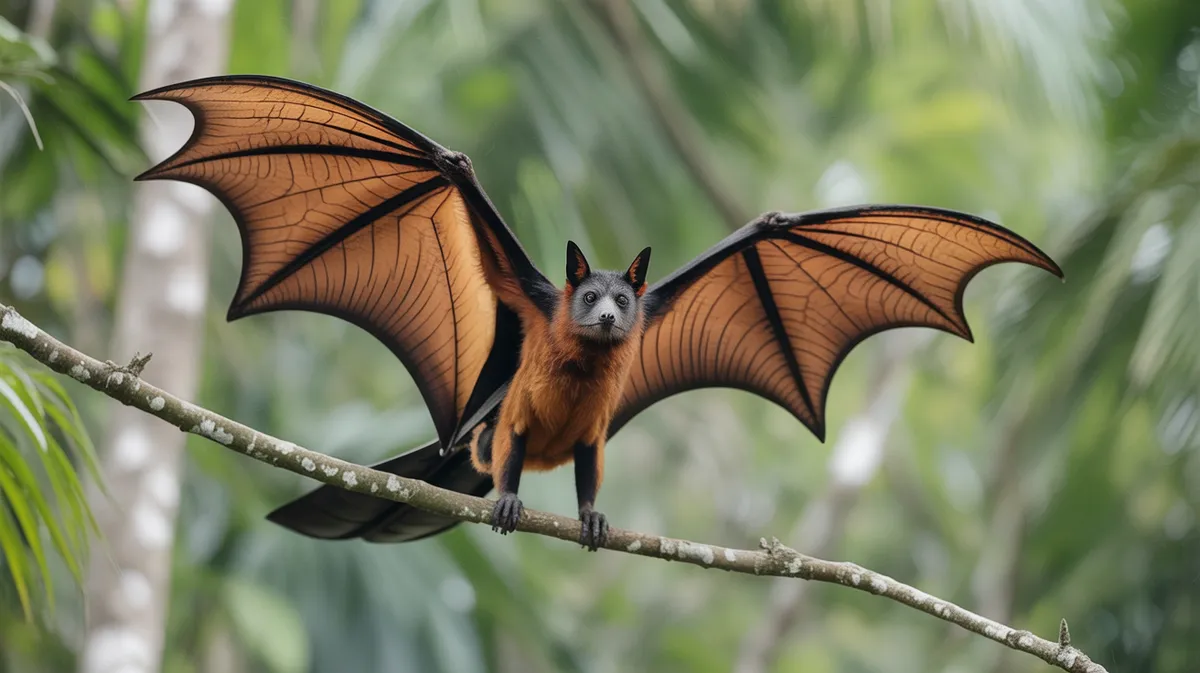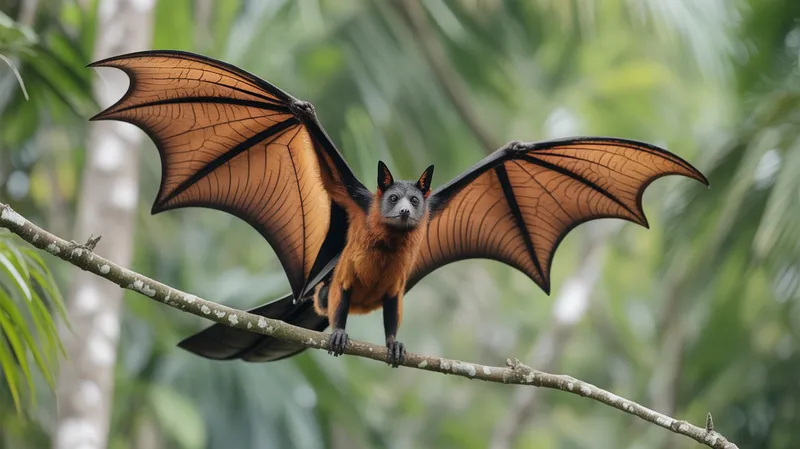
Madagascar Flying Fox
Pteropus rufus

Meet the Madagascar Flying Fox
The Madagascar Flying Fox is the largest bat species native to Madagascar, easily recognized by its fox-like face and large, leathery wings. These fruit bats are crucial pollinators and seed dispersers for Madagascar's forests, feeding on a variety of fruits, nectar, and flowers. They are highly social, roosting in large colonies in tall trees during the day and foraging at night. Sadly, their populations are under threat from habitat loss and hunting, leading to a decline in their numbers.
Classification
Mammal
Habitat
Tropical and subtropical forests
Diet
Herbivore
Lifespan
10-15 years
Conservation
Vulnerable
Weight
500-750 grams
📖Fascinating Facts
Gigantic Wingspan
The Madagascar Flying Fox boasts a wingspan that can reach up to 1.25 meters (4 feet), making it the largest bat species on the island.
Forest Guardian
By feeding on fruits and nectar, these bats play a vital ecological role as pollinators and seed dispersers for Madagascar's unique flora.
Sight Over Sound
Unlike many other bats, Madagascar Flying Foxes do not echolocate; they rely entirely on their keen eyesight and strong sense of smell.
📋Detailed Description
The Madagascar Flying Fox (Pteropus rufus) is the largest bat species endemic to Madagascar, with adults boasting a wingspan of up to 1.25 meters and a body length ranging from 23 to 27 centimeters. Their fur is typically a rich golden-brown to dark brown, with lighter coloration on the head and shoulders, giving them a distinctly fox-like appearance. The species exhibits pronounced sexual dimorphism, with males generally larger than females. Their elongated muzzle, large eyes, and absence of a tail are characteristic of the genus Pteropus. These bats possess robust, clawed thumbs for climbing and hanging from branches, and their leathery wings are adapted for sustained, energy-efficient flight over long distances. Pteropus rufus is highly gregarious, forming daytime roosts known as camps, which can contain hundreds to thousands of individuals. They are nocturnal foragers, relying on keen vision and olfaction to locate food. Their ecological role as pollinators and seed dispersers is vital for the regeneration of Madagascar's forests, as they feed on a variety of native fruits, nectar, and flowers. The species breeds seasonally, with a single offspring born annually, and exhibits extended maternal care. Their populations are declining due to habitat destruction, hunting, and disturbance at roost sites, making them a focal species for conservation efforts.
💡 Did you know?
Unlike most bats, Madagascar Flying Foxes do not echolocate—instead, they navigate and find food using their excellent vision and sense of smell.
🔬Research & Sources
🎭Behavior & Social Structure
Madagascar Flying Foxes are strictly nocturnal, leaving their communal roosts at dusk to forage across distances of up to 30 kilometers in a single night. Their diet consists primarily of figs (Ficus spp.), mangoes, bananas, and native forest fruits, but they also consume nectar and flowers, contributing to pollination. Feeding is a social activity, with individuals often congregating at fruiting trees, where vocalizations and wing displays help establish dominance and minimize conflict. During the day, they roost in large colonies in tall emergent trees, engaging in social grooming, vocal communication, and thermoregulation behaviors such as wing fanning. Colonies are structured with stable core groups, often consisting of related females and their offspring, while males compete for access to prime roosting spots and mating opportunities. The species is highly mobile, with seasonal shifts in roost locations in response to food availability and disturbance.
👶Reproduction & Life Cycle
Breeding in Pteropus rufus is seasonal, with mating typically occurring between April and June. Females give birth to a single pup after a gestation period of approximately 5.5 to 6 months, usually between October and December, coinciding with the onset of the rainy season and peak fruit abundance. Newborns are altricial, clinging to their mother's belly for the first several weeks. Mothers provide extensive care, carrying their young during nightly foraging trips until the pups are capable of flight at around 8 to 10 weeks old. Sexual maturity is reached at about 2 years for females and slightly later for males. Reproductive success is closely tied to food resource availability and the stability of roosting sites.
🛡️Adaptations & Survival
Pteropus rufus exhibits several adaptations for its frugivorous and volant lifestyle. Its large, forward-facing eyes provide excellent night vision, essential for nocturnal foraging. The elongated tongue and specialized dentition allow efficient extraction of juice and pulp from fruits and flowers. Their strong, flexible wings enable long-distance flight and agile maneuvering through forest canopies. Social adaptations include complex vocalizations and scent marking for communication and territory establishment. The species' ability to form large, cohesive colonies provides protection from predators and facilitates information sharing about food sources. Their metabolic rate is adapted to support high-energy flight while minimizing water loss, an important trait in Madagascar's variable climate.
📚Research Sources
🎨Cultural Significance
In Malagasy culture, the Madagascar Flying Fox is both revered and exploited. While some communities associate bats with ancestral spirits and view them as omens or protectors, others hunt them for food, considering their meat a delicacy. Traditional beliefs sometimes afford protection to roosting colonies, especially those near sacred sites, but these taboos are weakening under economic pressures. The species occasionally appears in local folklore and oral histories, symbolizing agility and resourcefulness. Conservation programs increasingly incorporate traditional knowledge and community-based approaches to foster coexistence and sustainable use.
🔬Recent Research & Discoveries
Recent studies have focused on the species' role in forest regeneration, highlighting its effectiveness as a seed disperser for endemic and economically important tree species. Genetic research has revealed low levels of genetic diversity within some populations, raising concerns about long-term viability. Satellite telemetry and stable isotope analysis have provided new insights into movement ecology, foraging ranges, and dietary preferences. Ongoing research is investigating the impacts of hunting and habitat fragmentation on population structure and reproductive success. Conservation biologists are also exploring the potential for roost protection and alternative livelihoods to reduce hunting pressure. The species has been identified as a priority for One Health research due to its potential role in zoonotic disease dynamics, though no significant disease transmission events have been documented to date.
🎥Wildlife Videos

Home to the Strangest Animals on Earth! 🦎 Wild Madagascar
Join us on an incredible journey as we delve into the fascinating world of Madagascar's unique wildlife! From the iconic lemurs to ...
Creaticles

UNIQUE BIRDS AND ANIMALS FOUND ONLY IN MADAGASCAR
UNIQUE BIRDS AND ANIMALS FOUND ONLY IN MADAGASCAR Embark on a journey to the extraordinary island of Madagascar ...
Bakht Academy

Weekly Wildlife: Malagasy Special
Featuring 7 Amazing animals from the Island of Madagascar. Art in this video belongs to the Artist Pterosaur-Freak and can be ...
Factutainment

The Megabat: The World’s Largest Bat Is Bigger Than You
A literal cold-blooded creature so impressive in size, people prefer to call it a flying fox. And when it takes flight, it defines what ...
Crazy Creatures

How Flying Fox does everything upside down
Hi, Welcome to amazing Animals. This channel is all about animals. If you cant get enough all things animal then you are going to ...
Eternally Raw

Healing Seekers Madagascar Bat Cave and Animal Cures
healingseekers
🌍Habitat Information
The Madagascar Flying Fox typically inhabits Tropical and subtropical forests environments. Madagascar Flying Foxs have adapted to their environments with specialized features and behaviors.
Primary Habitat:
Tropical and subtropical forests
More detailed habitat information will be available soon.
🛡️Conservation Status
The Madagascar Flying Fox is currently classified as Vulnerable. Conservation efforts are crucial for preserving this species for future generations.
Common Threats:
- 🏠Habitat loss and fragmentation
- 🌡️Climate change impacts
- 🎯Hunting and poaching
- 🏭Human-wildlife conflict
⚠️Threats & Conservation Challenges
The Madagascar Flying Fox faces significant threats from habitat loss due to deforestation for agriculture, logging, and urban expansion. Hunting for bushmeat, both for local consumption and commercial sale, is a major driver of population decline, particularly during the breeding season when bats are most vulnerable. Disturbance and destruction of roost sites further exacerbate their decline, as the species is highly sensitive to human activity. Climate change poses additional risks by altering fruiting patterns and increasing the frequency of cyclones, which can devastate roosting and foraging habitats. Population estimates suggest a continuing decline, with some local extirpations reported. Conservation challenges include enforcing hunting regulations, protecting critical roosting and foraging habitats, and engaging local communities in sustainable management.
🔬Scientific Classification
Scientific Name
Pteropus rufus
Classification Hierarchy
🔍 About Taxonomic Classification
Taxonomic classification is a hierarchical system used by scientists to classify and organize living organisms based on shared characteristics and evolutionary relationships.
The system moves from broad categories (Kingdom) to increasingly specific ones, with each animal's scientific name typically consisting of its Genus and species.
📝Community Notes
Share your observations and insights about the Madagascar Flying Fox with our community of wildlife enthusiasts.
Join Our Community
Sign in to share your observations and connect with fellow wildlife enthusiasts.
Sign In to ContributeNo community notes yet
Be the first to share your observations about the Madagascar Flying Fox!
Explore Madagascar Flying Fox
Select a tab above to learn more about this amazing animal.
📸Photo Gallery
No photos available for this animal yet.
🌟Discover More Wildlife
Continue your journey of discovery with more fascinating animals from our database
